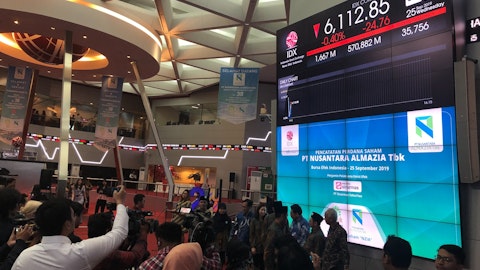And so that’s it. We — this last quarter, we — our business significantly declined as we — as we paused in the marketplace. We stopped shipping in the marketplace. We expect this quarter to be about the same. But after, that hopefully we can go compete for our business and do our best, and we’ll see how it turns out.
Operator: Your next question comes from the line of Harsh Kumar from Piper Sandler. Your line is open.
Harsh Kumar: Yeah. Hey, Jen-Hsun, Colette and NVIDIA team. First of all, congratulations on a stunning quarter and guide. I wanted to talk about, a little bit about your software business and it’s pleasing to hear that it’s over a $1 billion but I was hoping Jen-Hsun or Colette if you could just help us understand what the different parts and pieces are for the software business? In other words, just help us unpack it a little bit, so we can get a better understanding of where that growth is coming from.
Jensen Huang: Let me take a step back and explain the fundamental reason why NVIDIA will be very successful in software. So first, as you know, accelerated computing really grew in the cloud. In the cloud, the cloud service providers have really large engineering teams and we work with them in a way that allows them to operate and manage their own business. And whenever there are any issues, we have large teams assigned to them. And their engineering teams are working directly with our engineering teams and we enhance, we fix, we maintain, we patch the complicated stack of software that’s involved in accelerated computing. As you know, accelerated computing is very different than general-purpose computing. You’re not starting from a program like C++.
You compile it and things run on all your CPUs. The stacks of software necessary for every domain from data processing SQL versus — SQL structure data versus all the images and text and PDF, which is unstructured, to classical machine-learning to computer vision to speech to large-language models, all –recommender systems. All of these things require different software stacks. That’s the reason why NVIDIA has hundreds of libraries. If you don’t have software, you can’t open new markets. If you don’t have software, you can’t open and enable new applications. Software is fundamentally necessary for accelerated computing. This is the fundamental difference between accelerated computing and general-purpose computing that most people took a long time to understand.
And now, people understand that the software is really key. And the way that we work with CSPs, that’s really easy. We have large teams that are working with their large teams. However, now that generative AI is enabling every enterprise and every enterprise software company to embrace accelerated computing — and when — it is now essential to embrace accelerated computing because it is no longer possible, no longer likely anyhow to sustain improved throughput through just general-purpose computing. All of these enterprise software companies and enterprise companies don’t have large engineering teams to be able to maintain and optimize their software stack to run across all of the world’s clouds and private clouds and on-prem. So we are going to do the management, the optimization, the patching, the tuning, the installed-base optimization for all of their software stacks.
And we containerize them into our stack. We call it NVIDIA AI Enterprise. And the way we go to market with it is that think of that NVIDIA AI Enterprise now as a run time like an operating system, it’s an operating system for artificial intelligence. And we charge $4,500 per GPU per year. And my guess is that every enterprise in the world, every software enterprise company that are deploying software in all the clouds and private clouds and on-prem, will run on NVIDIA AI Enterprise, especially obviously for our GPUs. And so this is going to likely be a very significant business over time. We’re off to a great start. And Colette mentioned that it’s already at $1 billion run rate and we’re really just getting started.
Operator: Thank you. I will now turn the call back over to Jen-Hsun Huang, CEO, for closing remarks.
Jensen Huang: The computer industry is making two simultaneous platform shifts at the same time. The trillion-dollar installed base of data centers is transitioning from general purpose to accelerated computing. Every data center will be accelerated so the world can keep up with the computing demand, with increasing throughput, while managing costs and energy. The incredible speed up of NVIDIA enabled — that NVIDIA enabled, a whole new computing paradigm, generative AI, where software can learn, understand and generate any information from human language to the structure of biology and the 3D world. We are now at the beginning of a new industry where AI-dedicated data centers process massive raw data to refine it into digital intelligence.
Like AC power generation plants of the last industrial revolution, NVIDIA AI supercomputers are essentially AI generation factories of this Industrial Revolution. Every company in every industry is fundamentally built on their proprietary business intelligence, and in the future, their proprietary generative AI. Generative AI has kicked off a whole new investment cycle to build the next trillion dollars of infrastructure of AI generation factories. We believe these two trends will drive a doubling of the world’s data center infrastructure installed base in the next five years and will represent an annual market opportunity in the hundreds of billions. This new AI infrastructure will open up a whole new world of applications not possible today.





